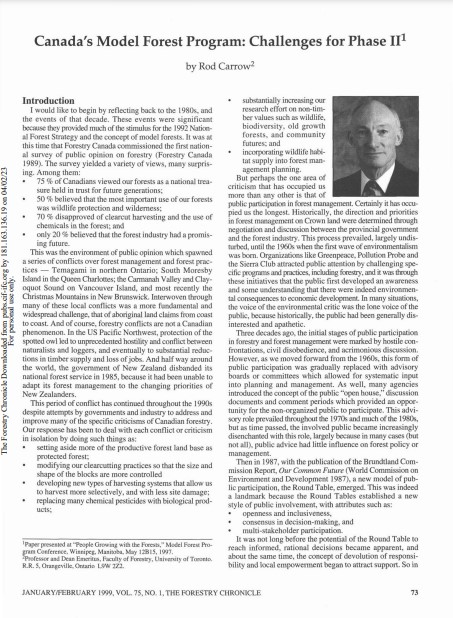Canada's Model Forest Program: Challenges for Phase II
Bosque Modelo:
Red Internacional de Bosques Modelo
Temática:
Gestión forestal
Tipo de documento:
Artículo científico
Resumen
I would like to begin by reflecting back to the 1980s, and the events of that decade. These events were significant because they provided much of the stimulus for the 1992 National Forest Strategy and the concept of model forests. It was at this time that Forestry Canada commissioned the fist national survey of public opinion on forestry (Forestry Canada 1989). The survey yielded a variety of views, many surprising. Among them: 75 % of Canadians viewed our forests as a national treasure held in trust for future generations; 50 % believed that the most important use of our forests was wildlife protection and wilderness; 70 % disapproved of clearcut harvesting and the use of chemicals in the forest; and only 20 % believed that the forest industry had a promising future. This was the environment of public opinion which spawned a series of conflicts over forest management and forest practices - Temagami in northern Ontario; South Moresby Island in the Queen Charlottes; the Cannanah Valley and Clayoquot Sound on Vancouver Island, and most recently the Christmas Mountains in New Brunswick. Interwoven through many of these local conflicts was a more fundamental and widespread challenge, that of aboriginal land claims from coast to coast. And of course, forestry conflicts are not a Canadian phenomenon. In the US Pacific Northwest, protection of the spotted owl led to unprecedented hostility and conflict between naturalists and loggers, and eventually to substantial reductions in timber supply and loss of jobs. And half way around the world, the government of New Zealand disbanded its national forest service in 1985, because it had been unable to adapt its forest management to the changing priorities of New Zealanders
Información Bibliográfica
Autor:
Carrow, R.
Revista:
Forestry Chronicle
Año:
1999
N°:
1
País :
Canadá
Páginas:
73 - 80
Volumen:
75
Idioma:
Ingles
Palabras claves
Model forest, Adaptatation





